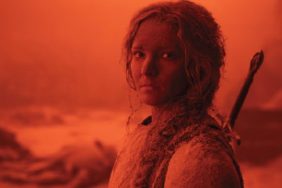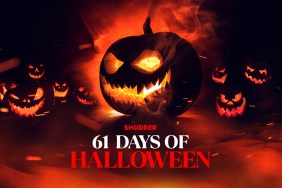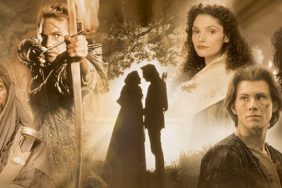
I know it may seem a bit overkill to tackle another Akira Kurosawa film in the Cinematic Revival considering this is only the eleventh installment and I already covered Seven Samurai. My reasoning is because I was so intrigued by Seven Samurai that after that film I watched Rashômon and didn’t cover it and now Throne of Blood and currently have Ran on the counter just waiting to be watched.
Kurosawa is one of the most interesting directors I have had the pleasure of watching and next week I will be covering another director that is entirely new to me, the late Ingmar Bergman. The primary curiosity surrounding Throne of Blood (Kumonosu jô) is that it is Kurosawa’s adaptation of Shakespeare’s “Macbeth”, written by Shinobu Hashimoto, Ryuzo Kikushima, Hideo Oguni and Kurosawa as well. Outside of Kikushima, Hashimoto and Oguni were frequent collaborators with Kurosawa and while I don’t think Throne of Blood is as good as either Rashômon or Seven Samurai it is highly interesting primarily due to its source material.
In the central role is Kurosawa favorite Toshirô Mifune playing Taketori Washizu, for those looking to compare to “Macbeth”, this is your Macbeth. The role associated with Banquo is played by Minoru Chiaki and named Yoshiaki Miki. Often referred to as the best adaptation of any of Shakespeare’s plays, Throne of Blood sticks very close to the source material and only alters details when it best suits the story and its genre. The most drastic changes involve the ending and the absence of the Macduff character. I will address these issues later on, but the decision to get rid of Macduff makes for a far more powerful ending if you ask me.

Throne of Blood is set in the feuding world of Japan and Washizu and Miki are returning to Spiders’ Web Castle to share their victory with their Great Lord. However, on their way home through Cobweb Forest they are confronted with a spirit of the forest in the form of an aged and ghastly old woman (represented by three witches in Shakespeare’s play). She lays out the future of the two soldiers and is gone. Obviously confused over what they have just seen and heard, neither of them is able to wholly slough off the good fortune that would soon place Washizu in command of Spiders’ Web Castle as well as Miki’s son would one day also gain control of the castle.

This now introduces one of my largest issues with this film. As the two soldiers make their way out of the forest they encounter a ghostly fog preventing them from seeing which way to go. The scene tends to go on, and on, and on as Washizu and Miki seem to go back and forth over the same ground for hours. There are two other scenes in Throne of Blood that suffer from the same tedious length issue, but the interesting thing about all three of them is that Kurosawa manages to offer up fantastic payoffs at the end of each. In this case Washizu and Miki finally make their way out of the forest and the castle can just barely be seen in the background as the fog is still lifting. The two soldiers take some time to rest and as they discuss the fortune just told to them in the forest the castle slowly reveals itself on the horizon. The scene is quite impressive. The question is whether or not the payoff is worth the tedium suffered prior. Personally I would have liked for it to be cut down, but it is a minor complaint for the time being.
Upon returning to the castle the first phase of the old woman’s prophecy comes true as both men are placed in positions of power throughout the land, but this is just the beginning, and it also brings us to the introduction of Kurosawa’s Lady Macbeth.

Isuzu Yamada plays Lady Asaji Washizu, and for Shakespeare enthusiasts you will see that Washizu is far tamer than Shakespeare’s Macbeth and Lady Asaji is far more evil than Lady Macbeth ever dreamed of being. Washizu becomes Asaji’s puppet as she takes the prophecy as relayed to her by her husband and instead of allowing the power as Great Lord sitting in Spiders’ Web Castle to come to them she asks Washizu to take fate into his own hands, this means assassinating the Great Lord just as Macbeth assassinated Duncan.
Much of what follows is incredibly similar to “Macbeth” as Washizu now tends to Spiders’ Web Castle as Great Lord following the assassination and continues to worry and react believing what he has done will soon be known by the people. This drives him to try and eliminate anyone that will stand in his way or may suspect his dirty deeds. This, of course, puts Miki and his son in great danger considering the old woman said that while Washizu would soon control Spiders’ Web Castle, so would Miki’s son. Much like the play, Washizu hires help to exterminate Miki and his son, and in a scene that is one of the most powerful of the film…

…an assassin returns carrying something round and covered in cloth. Immediately you know what it is and considering Kurosawa, at least in my experience, never resorts to overly violent imagery you don’t think you will actually see the severed head. He toys with this idea for a while creating immense suspense only to ultimately never make the reveal. The assassin soon reveals however that he was not entirely successful as Miki’s son managed to escape. Washizu’s paranoia is already at a frenzied state, but his lust for power is beginning to consume him and we begin to see a shift between Washizu and Asaji. Concern over what has transpired begins to consume Asaji as Washizu slowly fall into madness.

Word begins to spread that the lords of Japan are conspiring to overthrow Washizu and he returns to Cobweb Forest to find his ghost and hear a new prophecy. He is once again greeted by the same frightening old woman, but as the future is explained to him more and more ghosts begin to show, all with separate messages regarding Washizu’s fate. Most important of all is that he will always be lord until the forest comes to Spiders’ Web Castle. This is yet another detail from “Macbeth” realized in Throne of Blood.

Returning to the castle Washizu finds Asaji in a state of despair. Early in the film, following the assassination of the Great Lord, Asaji consoled Washizu as he was worried about not being able to clean the blood off his hands. An obvious metaphor, Asaji showed him how easy it was, leading us to this point in the film where Asaji is seen duplicating the washing movements she made earlier in the film. Shouting how the blood can never be washed away she scrubs her dry hands over and over. Obviously mad, there is one small difference between Shakespeare’s “Macbeth” and Throne of Blood here in that we never quite know the fate of Asaji. In “Macbeth”, Lady Macbeth commits suicide. Those that believe this film sticks that close to the play are sure to believe Asaji did the same, but it is never mentioned.
Lusting for power, Washizu’s own madness has now consumed him. He takes the latest prophecy he has heard at face value and believes himself to be indestructible. Without the fortune told in “Macbeth” saying that “none of woman born” could harm Macbeth, Washizu tells his men they will be victorious so long as the forest doesn’t come to the castle. They laugh off the notion and prepare for war with an army that far out numbers them.
Suddenly, something happens. The men begin to retreat. Washizu asks what is wrong. He is told the forest is moving and headed toward the castle. Of course the oncoming army has chopped down trees and is using them as protection as they ascend on the castle. Washizu looks on as his men calmly look onward. He turns to look at them and orders them to fight. They don’t move. He asks if they will allow their Great Lord to die and he is answered with the following…

The image above says it all. What really hit home for me was the fact that finally it is revealed that everyone was on to him the whole time. It had never been spoken of, all we saw was Washizu trying to cover his tracks and eliminate any threat. Unfortunately he never counted on his own men.
This brings us to our finale. Since there is no Macduff we have no hand-to-hand combat, and no gruesome reveal of Washizu’s decapitated head. Instead after he is asked, “And who killed our last Great Lord?” the arrows begin to fly. As you watch the following video know that every single arrow is real, including the last one, which I will explain following the scene.
First, for the arrows, yes, they are all real. Any of the arrows that hit Mifune’s body were probably lodging into a piece of wood under his armor. The final arrow that goes through his neck was actually achieved by shooting an arrow just in front of Mifune. The scene was then edited by placing a fake arrow on both sides of his neck at the same angle the original arrow was shot and resuming filming. Also interesting about the scene is the final slow motion fall of Washizu. I mentioned Kurosawa’s use of slow motion in my Seven Samurai piece, and just like the Seven Samurai scene, the use of slow motion here adds a lot of weight to the fall of the “monster”.
Aside from the actual story elements that were changed from “Macbeth”, the political flattery also wasn’t necessary as Shakespeare shows much love for James I in his play. Many mention that Kurosawa also wasn’t constrained by keeping the poetic verse of the play since it was in a foreign language. Personally I think that is a cop out for anyone that has failed at adapting Shakespeare. Kurosawa and his team of screenwriters simply took the story of “Macbeth” and turned it into a movie, the poetic verse should be saved for stage as that is where it is best served.
While I don’t believe Throne of Blood is all that great of a film when compared to other Kurosawa features, it is certainly worthy of mention. I love Shakespeare adaptations and this one is interesting for that fact alone. I also love Kurosawa’s style of filmmaking. His films are dark and brooding. The cinematography of Asakazu Nakai is fantastic, which is saying a lot for a black and white film and the acting is always top notch.
I do think Mifune may have gone a little more over the top than necessary with his portrayal of Washizu, but he is Toshiro Mifune and that is what you get from him. Anyone that has seen the man in action would never expect any less. The most impressive performance in the film, however, is from Isuzu Yamada as her portrayal of Asaji is truly evil. She breathes villainy and to see her fall into madness at the end only seems appropriate.
Throne of Blood is not the best film I have explored in my Cinematic Revival, but it is certainly worthy of a watch should you have the time. For more on the film you can get the trailer here, the Criterion DVD info here and 22 pics from the film here. The pictures are all the best screen caps I could get from the DVD, including that final shot of Washizu. Definitely worth a browse.
Stay tuned as my next Cinematic Revival will explore Bergman’s Seventh Seal, a film I happily place inside of my top 25 of all time, it is truly amazing.










